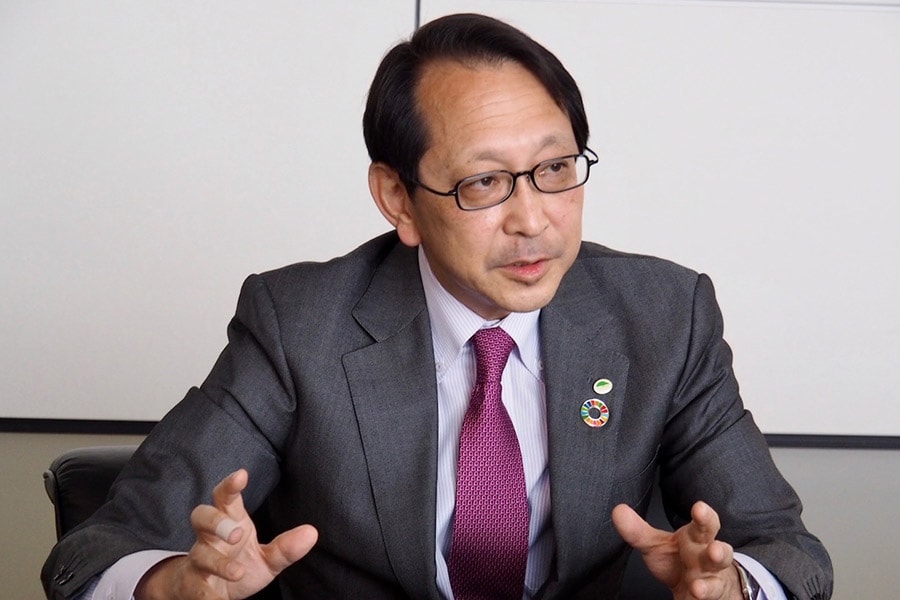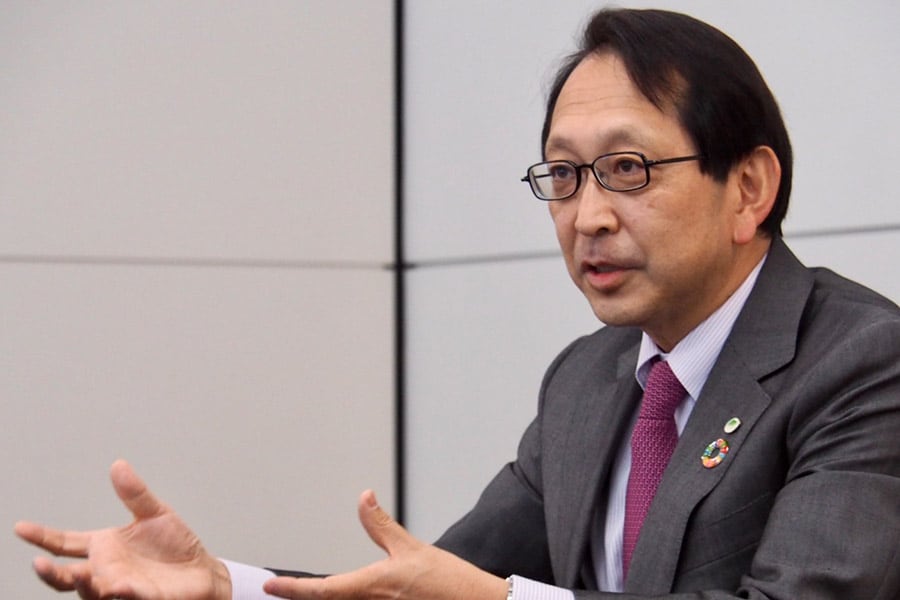Chief Human Resources Officer of Hitachi talks about new workstyle after COVID-19
Jul. 1, 2020
Yoshihiro Teramoto

On May 26, Hitachi, Ltd. announced its new workstyle in anticipation of a "new normal” after COVID-19. Basing remote working as the next standard, the new workstyle is set to drive workstyle diversification across the company. At the same time, it will accelerate the conversion to job-based HR management—an approach to employment that defines work, roles, and expected results in order to raise employee productivity.
Why is Hitachi trying to shift its workstyle? What is the “new normal” workstyle anticipated? To find the answers to these questions, we spoke with Hidenobu Nakahata, Senior Vice President and Executive Officer at Hitachi, who also serves as Chief Human Resources Officer (CHRO).
Advantages and challenges revealed in the shift to remote work
Q: First, please tell us what kind of initiatives you have carried out in response to the spread of the COVID-19.
Nakahata : Our primary consideration was the health and safety of the employees working with our customers, business partners, cooperative companies, as well as their families. To this end, we made a strong commitment to allow employees to work from home. We were able to make the shift to remote work without causing major confusion because we had already been implementing systems and building IT environments for the expansion of working remotely.
Q: Regarding your strong commitment to remote work, how much of your workforce is now working from home?
Nakahata : The percentage of those working from home, following the national COVID-19 emergency declaration in Japan, was over 80% in the seven affected prefectures and 70% for the country overall, enabling us to play our part in measures for preventing infections. In May, we conducted a survey on remote work for Hitachi employees, through which we found out its advantages and future challenges.
Q: What kinds of advantages and challenges were there?
Nakahata : In this survey, some people reported that they were able to use the time previously used to commute effectively and that they were able to concentrate on their work. A total of 50% said that their work efficiency had either risen due to remote work or had not changed. Conversely, 50% said that their efficiency had dropped, citing slow PC response speed, hindrance to work due to not being able to stamp or print out documents, and other such opinions.
We also discovered that defining the required work and evaluating results was also a challenge when working remotely. This is because one outcome of remote work was that instructions could no longer be given in person, making it difficult to ascertain and evaluate the work status of individuals.
What will be the new workstyle at Hitachi?

Q: Despite the various challenges that was revealed after implementing remote work, you announced that you would promote a workstyle based on remote work as the new standard. Please tell us about your aims in doing this.
Nakahata : I believed that, in response to the COVID-19 crisis, we should shift to the so-called "new normal" rather than return to our previous, conventional way of working. From the standpoint of creating systems for continuing to work amid the COVID-19 pandemic while improving productivity and developing diverse workstyles, I considered it necessary to change our course to new workstyles predicated on living with this new virus.
Therefore, while declaring a policy of continuing, in principle, remote work until the end of July, I thought that I should announce both internally and externally the kind of workstyle that Hitachi is aiming for in a long term.
Q: We can say that it is precisely because Hitachi bears responsibility for social infrastructure that there is demand for building systems that enable business to continue even in times of crisis. What kinds of workstyles are you expecting from employees?
Nakahata : Hitachi Group has a global workforce of about 300,000 employees. Having such a large diversity of human capital, Hitachi as an organization embraces the importance of welcoming various values and individual’s strengths to manifest themselves and play active roles.
As a result of, in principle, implementing remote work, Hitachi employees have experienced going outside the boxes of time and place and working seamlessly. In addition to achieving this type of workstyle, I believe it’s necessary to accelerate the conversion to job-based HR management, an approach that Hitachi has been pursuing for some time, in order to find solutions to the challenge mentioned previously regarding how to define individual’s tasks and evaluate results.
Q: What is job-based HR management?
Nakahata : Job-based HR management refers to an approach in which employees identify their career goals while the company identifies duties and necessary skills and assigns people who are capable of taking on the work, in accordance with personal ambitions and competencies irrespective of age and other attributes.
Such an approach allows each person in a diverse workforce to work while exercising their unique expertise, leading to the proper determination of treatment based on work contents and execution ability.
Q: Please talk about your aims in switching to the job-based system.
Nakahata : Because remote work makes it difficult to see the progress of the employees’ work, the proper evaluation of outputs and contributions has taken on even more importance. Introducing a job-based management system will enable us to precisely define jobs and to visualize who is doing what kind of work and how they are doing it.
As it strengthens acceptance and understanding from both sides of one who evaluates and one who is being evaluated, it was clear that switching to a job-based system was crucial to using workstyles based on remote work as the standard. Another of its good points is that it leads to employees developing an awareness of career paths and creating a career on their own. Hitachi already converted to a job-based HR treatment system in 2014 at the managerial level. In the future, I would like see such a system implemented at non-managerial levels as well.
Looking forward to the new workstyle and the future society

Q: I feel that the new workstyle announced by Hitachi is quite an advanced approach. On the other hand, I think there were probably people within the company who opposed against it.
Nakahata : It's not just the good and bad of working at home, gaining understanding from family members is also crucial. This has led to some feedback about hardships in the conversion of workstyle.
In the execution of corporate activities, it is important that we convert to a workstyle predicated on living with COVID-19 while recognizing that this is a good opportunity to push the shift to a job-based system. I think that we can give impetus to the new workstyle while listening carefully to employee feedback and gaining their understanding of how effective it is.
Q: I'm sure other companies are directing their attention to the challenge of conversion to a new workstyle in which Hitachi is engaged. Will Hitachi's success become a test case for Japanese companies?
Nakahata : For employees around the world to play active roles globally, I believe that a system adapted to global standards is a necessity. In this respect, the conversion to a workstyle based on remote work as a new standard and to being job-based may very well represent the model of an approach for Japanese companies doing business globally.
Q: Will the conversion to the new workstyle be smooth?
Nakahata : I believe that the conversion to job-based system will enable each employee to improve their expertise and productivity without the constrictions of time and place. Job-based system will make working easier for everyone, and it will make it possible for us to approach work with enthusiasm. Given Hitachi's role in bearing responsibility for the social innovation business, as long as its employees—who are also members of the society—work together as one, it will always be possible to realize new ways of working.



